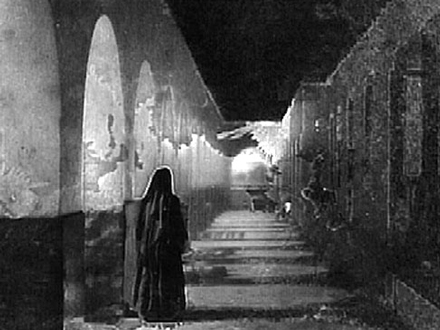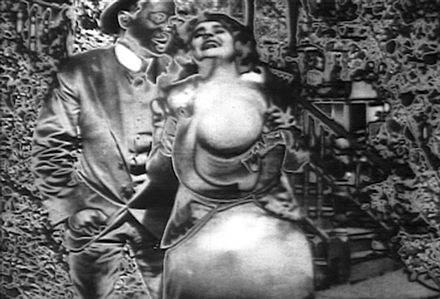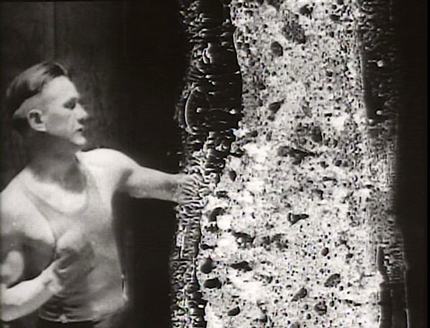
 |
|
|
|
As experimental filmmakers go, Bill Morrison has been doing something right. He's won fellowships and grants throughout his career and his films have become part of the collection of The Museum of Modern Art. He's also worked with a pantheon of top progressive music composers. Another new Icarus Films disc contains an interesting mix of Morrison's work. The Miner's Hymns (2011) juxtaposes aerial shots of the modern East England countryside with historical footage of the mines that were worked there, and the now-forgotten labor actions of the 20th century. The musical accompaniment is by the Icelandic composer Jóhann Jóhannsson. On a more conceptual level, Outerborough is a found-footage exercise that manipulates an ancient shot taken from a vehicle traversing the Brooklyn Bridge in 1899, superimposing the film on itself in different ways. Making an even more undefinable effect is Release, a film festival winner that uses a split screen to examine and repeat a single shot of Al Capone being released from a prison. Morrison's most noted picture appears to be 2002's Decasia, which may be the ultimate in experimental found-footage films. The historical champion of this kind of picture is the multi-media surrealist Joseph Cornell, whose Rose Hobart simply chopped up various bits of the actress's movie East of Borneo to form a 'story' with no narrative, only emotional close-ups and meaningless cutaways. As such it replicated the ideal theoretical movie experience of the early surrealists. They aspired to strip away narrative convention, theme and moral considerations to produce free-flowing visual experiences, whose meaning would be conjured in the mind of the viewer. 
The film Decasia was originally produced as a video accompaniment to the Ridge Theater's live multimedia theatricalization of composer Michael Gordon's Decasia, described as "an environmental symphony with projections." The presentation used imaginative staging and scenery as well. The title Decasia appears to be a pun word combination of 'decay' and 'fantasia'. Morrison has gone to film archives and scanned sections of badly deteriorated nitrate motion picture film. Film fans are accustomed to seeing occasional marring and blemishes on silent films, even those by famous names like Buster Keaton. Not all of Keaton's pictures have survived, and a few of those have scenes or shots recovered only in a partial state of deterioration. At UCLA we were shown plenty of samples of decayed nitrate film. The beautiful clear emulsion, the part of the film carrying the photographic image, can look as if it were hit with blisters, partially dissolved with acid or melted by heat. For whatever reason -- dryness, moisture, chemicals, heat, fungus -- the emulsion has begun to deteriorate, to turn back into powdered silver nitrate. Which films do and which don't decay is pretty much the luck of the draw. The chemical rot is built into the formulation and some films are more prone to break down than others. Badly rotted nitrate is routinely set aside, or destroyed for safety reasons. We were shown rolls of nitrate that had fused into a solid blocks of film, crumbling into powder. In some cases the fused rolls was moist with drops of liquid nitrate, like dynamite left in the heat too long. Although archivists try not to project decayed films, pliable sections can be fed through a film scanner and transferred to video just like a normal film. The difference is of course that the deteriorated parts of the film obscure the images, either a little or a lot. Decasia assembles about 48 minutes of 'eroded' cinema to serve as a mysterious illustrative background for Michael Gordon's orchestral music, played by the 55-piece Basel Sinfonietta. Some of this experimental music sounds like the Ligeti wails in the musical selections for 2001: A Space Odyssey. A sample of the Decasia effect can be seen at the Bill Morrison Website. Many shots are only intermittently affected, such as the scene of a dervish dancer that opens and closes the picture, and a long take shot in what appears to be a mission or church school, with nuns leading children from building to building. Along the way, we recognize little save for the unmistakable face of western star William S. Hart, standing proudly under the ravaging film damage that 'erases' most of the image around him. Another shot almost completely wiped out reveals what seems to be Mary Pickford, sitting down with a child. 
Within a minute or two Decasia one's mind begins reacting to these images, and meditating on their mystery. We of course think about the cause of the decay. We then notice that some of the images that have been obliterated must originally have been quite beautiful. Film fans will recall borderline- lost movies that one wishes could be seen once again in their virgin state. That of course leads to the known fact that film by its nature will not last forever, that every film we see will someday be lost. They no longer are made of unstable nitrate but the manufacturers cannot say if new archival stocks (not yet in heavy use) will survive over 100 years. A basic appeal of photography is that one might be creating an image that will last forever, a notion that Decasia cruelly dispels. This meditation on the ephemeral nature of things applies to the subjects on the films too. The children in the images have all now grown ancient, or more likely, are long gone. For many films taken over 100 years ago, identifying anything about them is impossible. And we wonder why we can't find hard information about events and people from 2,000 years ago. How many of us can assign names to our own great-great grandparents? Once or twice in the course of the film Morrison shows footage taken in a primitive film lab, where loops of film dip into tanks of chemicals, overseen by workers. There's nothing magical about the process, until one realizes that the film strips being produced are now an irreplaceable record of the past. That's the practical side of our thinking process. We're also reacting to the nature of the images. Behind the flickering, chattering patterns of decay remain slivers and islands of smooth, velvety images. Some images appear to be transformed without being destroyed, inverting a range of densities as if solarized or posterized. The decay affects some images -- or us -- in strange ways, as if revealing ghosts behind the damage, like a truth trying to get loose, or a 1905 film star saying, "I don't want to die". The partial, obscured, intermittent nature of the images 'eaten up' by the film damage also remind us of dream visions, the kind that fade away in the process of being remembered. Some images are abstracted to the point that they resemble the 'dream recordings' in Wim Wenders' science fiction film Until the End of the World. As the images have been arrested in the process of decay, we are also reminded of Hollis Frampton's superb experimental film (nostalgia), a meditation on lost objects, lost images, lost memories. 
Decasia sometimes baffles us with the weird patterns left by the decay, which can resemble black dots, twisted black rectangles, erosion-like cracks, and infestations of mold or algae. Morrison seems aware of this when a few of the damaged shots are actual microphotography of bacteria, etc. -- for a moment we think the microbes are eating up the film and causing the decay. In some images the edges of the emulsion near the damage appear to twist and distort, giving the impression of some kind of interruption of time and space. Finally, at least one shot seems an intentional joke -- a boxer practices on a punching bag, but the bag is completely masked by fuzzy deterioration damage. It looks as if the boxer is trying to knock the decay away with his punches. Decasia officially has five movements, unmarked in the film: creation, civilization, conundrum, disintegration & rebirth. The lengthy end titles show that the film was produced with the help of many grants and aided by other filmmakers... Godfrey Reggio's Qatsi crowd of producers are among those thanked. It's also amusing to see white flecks on the black leader at the end of the titles... it's as if the devil decay isn't giving up, and has made his mark on this picture too. Icarus Films' Blu-ray of Decasia is a handsome rendering of this unusual experimental film, with Michael Gordon's experimental music playable in 5.1 stereo surround or 2.0 stereo. Icarus gives us a special extra, Bill Morrison's 2003 film Light is Calling (2003). Clocking in at 8 minutes, the picture is a found section of the 1926 psychological horror film, The Bells. The scene on view shows the captain (Edward Phillips) of a mounted troop on the road, discovering a beautiful woman (Lola Todd) in the back of a hay wagon. I'd say that the film is about 70% obliterated, leaving us to squint and strain to assemble an idea of what's going on, and to see what the actors look like! We're accustomed to 'restoration comparison' features on DVDs of vintage films, and in some of them we wonder if the people involved were tempted to make the 'before' look worse than it is, for the purposes of contrast. If a perfect copy of The Bells existed, comparing it to the shots in Morrison's Light is Calling would make a great gag film ... "our new digital software turned this.... into this!"
On a scale of Excellent, Good, Fair, and Poor,
Decasia Blu-ray rates:
Reviews on the Savant main site have additional credits information and are often updated and annotated with reader input and graphics. Also, don't forget the 2011 Savant Wish List. T'was Ever Thus.
Review Staff | About DVD Talk | Newsletter Subscribe | Join DVD Talk Forum |
| ||||||||||||||||||